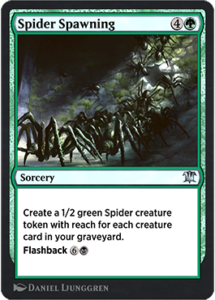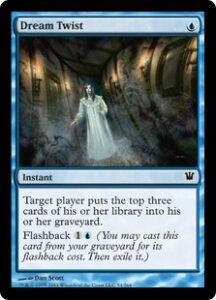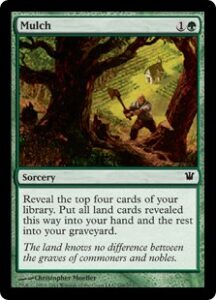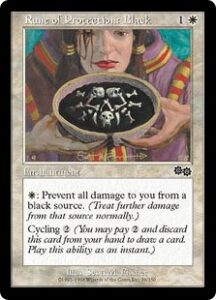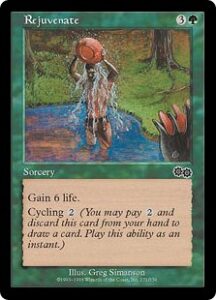When I play 41 in Limited

One interesting discussion did take place this weekend. Ryan Saxe started a Twitter discussion about when playing 41 cards in Limited is the right move.

There’s a lot of reasons people do it, such as wanting their land ratio to be 18:23 or thinking they’re going to see the bottom of their deck because of a self-mill.
The most useful argument against 41 in a Limited deck is that the power level of your cards have a huge range.
Your best card is usually so much better than your last card that you want to draw your best card as often as possible. Increasing your deck size by 2.5% is not acceptable if you have Umezawa’s Jitte in your deck.
You really want to draw it, and you’d play 30 or less cards if you could just to maximize your chances of doing so.
However, cards these days have a flatter power level than they had in the past, but it’s still not close enough to warrant adding cards.
It seems like 61 is more reasonable in most cases in Constructed than 41 would be in Limited, but we rarely if ever see 61.

Why is that?
The math on how many lands your deck should have is complex and rarely, if ever, do people do the math while constructing a Limited deck.
Mostly I think this is used to avoid making a tough decision on what to cut, what the land count should be, or how many of each mana source, and there’s a logical scapegoat for such a scenario so people overuse it.
Magic is meant to be fun, especially in today’s organized play climate, and if you don’t want to make a tough decision, you’re not losing a ton by playing one extra card.
Even Seth Manfielld, one of the best players of all time, indicated on Twitter he plays 41 if he doesn’t feel like cutting something.
Personally, I like puzzles and trying to find solutions, but some just want to play the game and solve those in-game puzzles. I have more fun solving the ones outside in deck building, drafting, or whatever.

Now for the self-mill situation.
This is also complex and still needs to pass a “do you have a card that’s substantially better than others” test.
Personally I did it maybe once every two or three times I drafted Spider Spawning decks in Innistrad Limited.
This was an archetype that had tons of self-mill depth-a card far better than the rest to draw, but it relied on having a certain number of creatures.
This card you wanted to find could also show up in your graveyard and be enough to win, which is another reason it seemed more acceptable to me.
Sometimes I didn’t have good creatures that milled and counted as a creature, but I did have the namesake card or two, and I’d be able to mill myself with cards like Dream Twist and Mulch.
I’d play 42 or 43 cards to get a high enough creature, land, and self-mill count, and I was likely wrong in almost all circumstances.
I did it because I didn’t know what was right, so I made some logical shortcuts that I could accept, and that’s a big part of this guessing game.
If you think you’re likely to make the incorrect decision, try to make the one that is the least wrong.
If something feels right to you, just do it and don’t worry about the peanut gallery.

This is the lesson I’d take away from what Seth said on Twitter.
I’ve won a lot of matches with 41 card Limited decks, but it’s not the usual reason, and it’s in a specific situation in a specific format.
I generally always submitted 40 cards, but when I was drafting a lot of Urza’s Saga block or Urza’s Saga x3 drafts, I often would end up siding into 41 cards.
Most often this would happen in UW Control style decks that I drafted regularly.
The format had Rune of Protection and protection from colors everywhere, so it was easy to lock out opponents, especially if they were heavy red or black decks that couldn’t remove enchantments.
Often I’d have a deck with so few win conditions that when I met a mirror match or a good black deck with tons of removal, I’d be able to stop them from winning, but I wouldn’t have an actual way to cross the finish line.
I realized at some point I should start siding in an extra card on the draw to manipulate the size of my deck when my opponent did not mulligan.

This way I’d still deck last.
I’d be cautious about cycling only when it was fully necessary or when my opponent had also done so.
This plan worked because there was little card draw in the set.
There was the occasional Opportunity, but there wasn’t a ton of “draw a card” tacked onto cards outside of cards with cycling.
I first discovered this in my first ever PTQ win at 15-years-old. I was going to game three with a GB deck with only one Elvish Lyrist to remove enchantments and an opponent who had multiple copies of the black and green Runes.
Went to game three, devastated that it would end this way because despite taking full control of game two, I couldn’t find a path to victory.
I decided I’d sideboard in a Rejuvenate in case my opponent didn’t keep a close count on my deck, and I could maybe win that way.
Hey, the card had cycling anyway.
I ended up casting the Rejuvenate in my game to fuel more activations of Pestilence, and while I didn’t deck my opponent, I got down to my last card before I won.
In formats where card drawing is light and deck size can be a resource, I can see 41 being correct, even to start.
While I think I was likely wrong to sideboard in the extra card in the PTQ because drawing Pestilence was probably more important, the idea of having a larger deck than your opponent at the time was often correct, as I can remember decking my opponents in this format.
This format did meet a lot of criteria where it was slow enough that the games would often evolve into this state,I didn’t have game-winning rares to draw, and I didn’t have a card like Opportunity, which I’d cast either on myself or use to kill my opponent.
Why playing 41 cards?
If you’re going to play 41 in Limited, it’s a good idea to evaluate the reasons you’re doing it, make sure you answer:
“No” to “Do I have a card that will almost always win me the game when I draw and cast it?” and “Yes” to “Do I have an actual strategic reason for this?”
Otherwise, you’re likely better off cutting that 18th land or cutting that extra solid common you think in most cases is uncuttable.
Image Copyright: (c) 1995-2020 Wizards of the Coast LLC, All Rights Reserved





